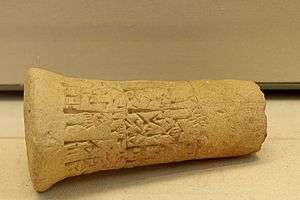Bad-tibira
Bad-tibira(Sumerian: 𒂦𒁾𒉄𒆠, bad3-tibiraki), "Wall of the Copper Worker(s)",[1] or "Fortress of the Smiths",[2] identified as modern Tell al-Madineh, between Ash Shatrah and Tell as-Senkereh (ancient Larsa) in southern Iraq,[3] was an ancient Sumerian city, which appears among antediluvian cities in the Sumerian King List. Its Akkadian name was Dûr-gurgurri.[4] It was also called Παντιβίβλος (Pantibiblos) by Greek authors such as Berossus, transmitted by Abydenus and Apollodorus. This may reflect another version of the city's name, Patibira, "Canal of the Smiths".[5]
Bad-tibira | |
|---|---|
 Bad-tibira Location in Iraq | |
| Coordinates: 31°22′47″N 45°59′59″E |
History

According to the Sumerian King List, Bad-tibira was the second city to "exercise kingship" in Sumer before the flood, following Eridu. These kings were said to be En-men-lu-ana, En-men-gal-ana and Dumuzid the Shepherd.
The early Sumerian text Inanna's descent to the netherworld mentions the city's temple, E-mush-kalamma. In this tale, Inanna dissuades demons from the netherworld from taking Lulal, patron of Bad-tibira, who was living in squalor. They eventually take Dumuzid, who lived in palatial opulence at Uruk. This Dumuzid is called "the Shepherd",[6] who on the King List resides at Bad-Tibira in contrast to the post-diluvian Dumuzid, the Fisherman, who reigns in Uruk.
The "brotherhood text" in cuneiform inscriptions on cones plundered from the site in the 1930s records the friendship pact of Entemena, governor of Lagash, and Lugal-kinishedudu, governor of Uruk. It identifies Entemena as the builder of the temple E-mush[7] to Inanna and Dumuzid, under his local epithet Lugal-E-mush.[8]
Archaeology
Some badly effaced half-bricks on the surface of the mound bore the inscription of Amar-Sin, of the Third Dynasty of Ur. Pieces of vitrified brick scattered over the surface of the large mound bore witness to the city's destruction by fire.[9] Possession of the city passed between Larsa, whose king Sin-Iddinam claims to have built the great wall of Bad-tibira, and Isin, whose king Lipit-Ishtar, "the shepherd of Nippur", claimed to have built the "House of Righteousness" there.[10]
See also
- Cities of the Ancient Near East
Notes
- W.F. Albright and T.O. Lambdin, "The Evidence of Language", in The Cambridge Ancient History I, part 1 (Cambridge University Press), 1971, ISBN 0-521-07051-1, page 150.
- Hallo, William W. and William Kelly Simpson, The Ancient Near East: A History, Harcourt Brace Jovanovich, Inc., New York, 1971, p. 32
- Vaughn E. Crawford, "The Location of Bad-Tibira", Iraq 22 "Ur in Retrospect. In Memory of Sir C. Leonard Woolley" (Spring - Autumn 1960:197-199); the secure identification is based on the recovery at the pillaged site of fragments of a known inscription of Entemena that had surfaced in the black market without provenance. Earlier excavations at a mound called Medain near the site of Lagash, following a report of a vendor of one of the inscriptions, had proved fruitless: see H. de Genouillac, Fouilles de Telloh, ii:139 (noted by Crawford 1960:197 note 7).
- Collection of taxes from Dûr-gurgurri features in correspondence of Hammurabi (first half of the 18th century BCE) noted in L. W. King and H. R. Hall, Egypt and Western Asia in the Light of Recent Discoveries (New York, 2005) p. 306f; it remained a city of metal-workers and the principal settlement of the guild of gugurrē, "metalworkers" (L. W. King, The Letters And Inscriptions Of Hammurabi, King Of Babylon About B.C. 2200 vol. III, p. 21, note 2.).
- Hallo, William W. and William Kelly Simpson, The Ancient Near East: A History, Harcourt Brace Jovanovich, Inc., New York, 1971, p. 32
- Inanna's descent to the netherworld - ETCSL
- Presumably the same temple as E-mush-kalamma, according to Crawford.
- Crawford 1960:197.
- Crawford 1960:198.
- Ferris J. Stephens, "A Newly Discovered Inscription of Libit-Ishtar" Journal of the American Oriental Society 52.2 (June 1932):182-185) p. 183.
Further reading
- W.F. Leemans, Tablets from Bad-tibira and Samsuiluna's Reconquest of the South, JEOL, vol. 15, pp. 214–218, 1957/58